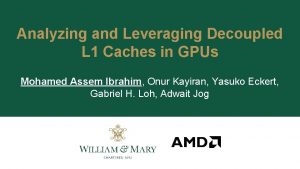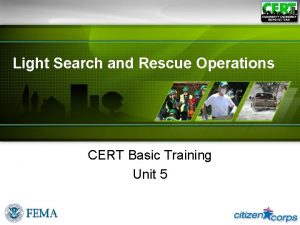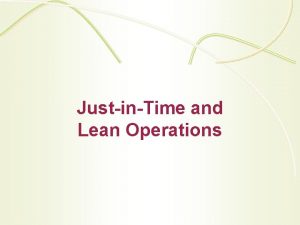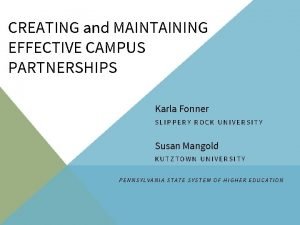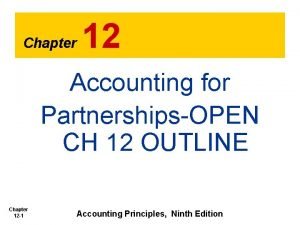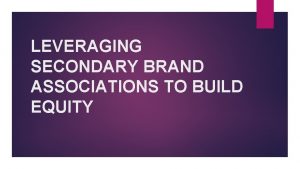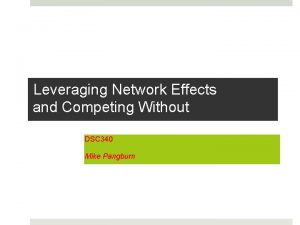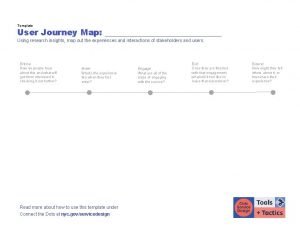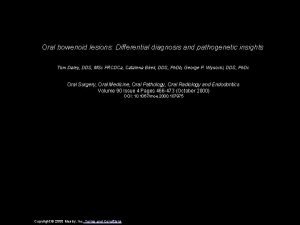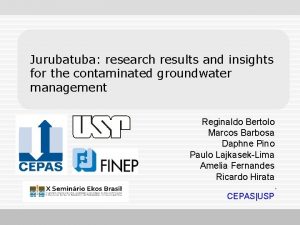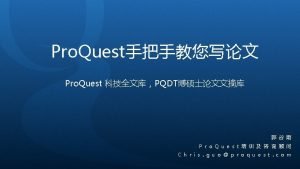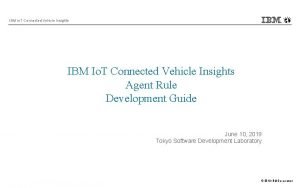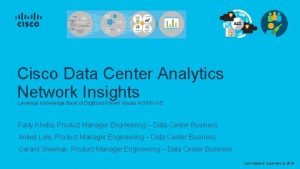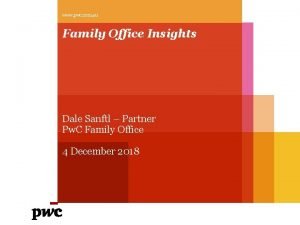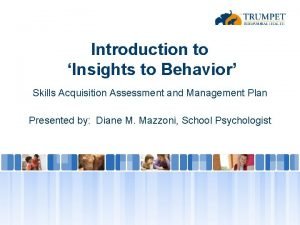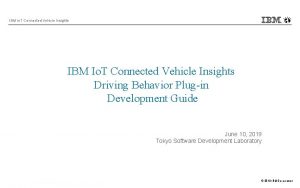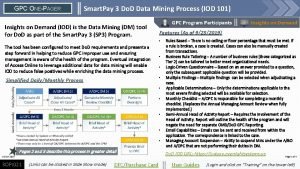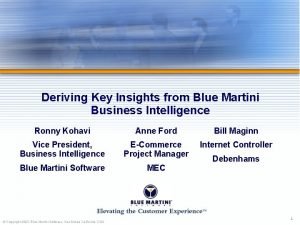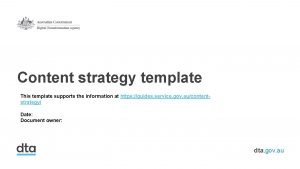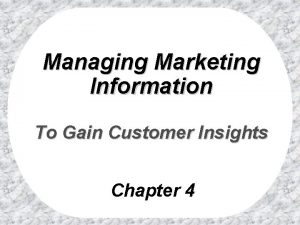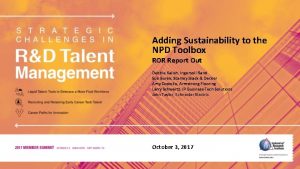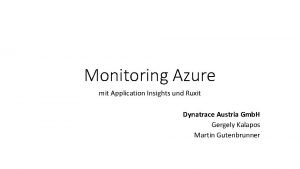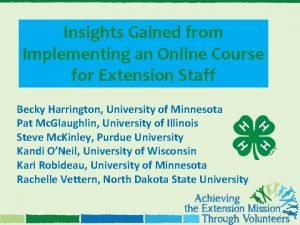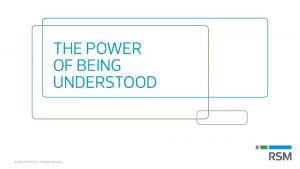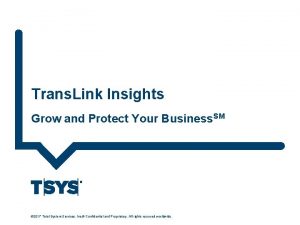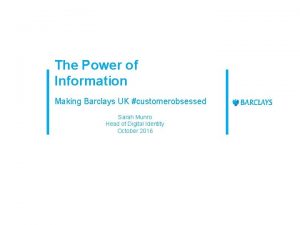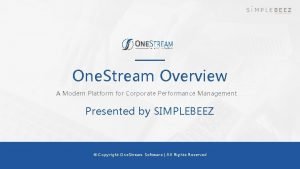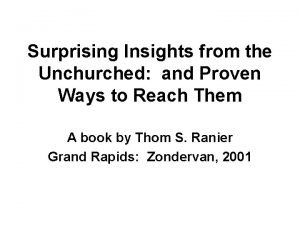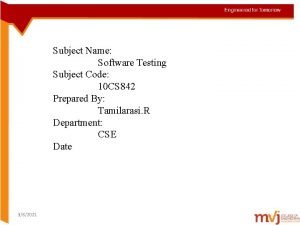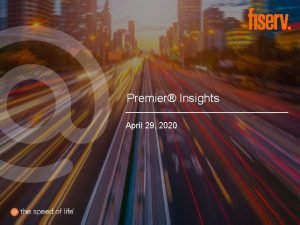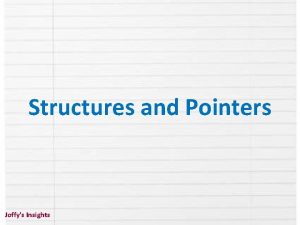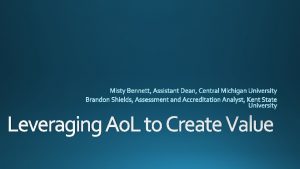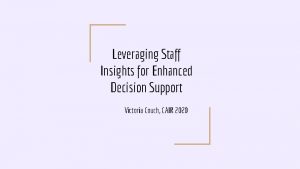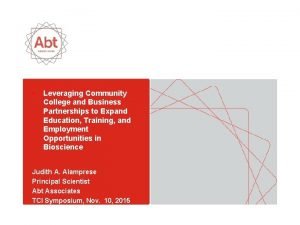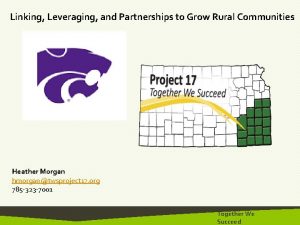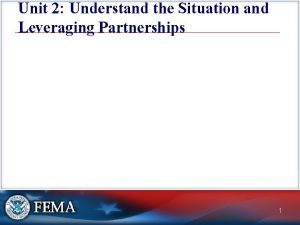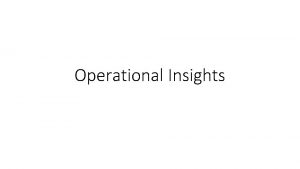National State and EMAlevel Insights Leveraging Partnerships Data









































![[Legacy System] On average, how much time do you spend per week working with [Legacy System] On average, how much time do you spend per week working with](https://slidetodoc.com/presentation_image/b68bc70866e90d04ffbd6534d1ded3af/image-42.jpg)
![[Legacy System] My current system is slow or unavailable at times and slows down [Legacy System] My current system is slow or unavailable at times and slows down](https://slidetodoc.com/presentation_image/b68bc70866e90d04ffbd6534d1ded3af/image-43.jpg)
![[Legacy System] I have to look for information instead of my data tools telling [Legacy System] I have to look for information instead of my data tools telling](https://slidetodoc.com/presentation_image/b68bc70866e90d04ffbd6534d1ded3af/image-44.jpg)
![[Legacy System] I think the work processes can be changed to be more effective [Legacy System] I think the work processes can be changed to be more effective](https://slidetodoc.com/presentation_image/b68bc70866e90d04ffbd6534d1ded3af/image-45.jpg)
![[Legacy System] How effective and efficient is it for you to monitor data quality [Legacy System] How effective and efficient is it for you to monitor data quality](https://slidetodoc.com/presentation_image/b68bc70866e90d04ffbd6534d1ded3af/image-46.jpg)


























- Slides: 72


National, State and EMA-level Insights: Leveraging Partnerships & Data Systems for Program Monitoring and Outcomes Session ID: #11077 Health. HIV, Louisiana Office of Public Health, Tampa St. Petersburg EMA, RDE Systems

Introductions

Who is in the audience? e 2 Polls Poll. rde. org

Leveraging Data to Develop Innovative Responses to Healthcare Landscape Changes Shayna Linov Fiscal Health Manager, Health. HIV

Learning Objectives • Describe insights of Health. HIV’s Inaugural State of ASOs/CBOs National Survey. • Explain implications of survey findings on program sustainability, service availability, and infrastructure capacity of AIDS Service Organizations/Community-Based Organizations (ASOs/CBOs). • Identify training and technical assistance needs of ASO/CBO leaders to increase sustainability of community-level HIV services.

Shifts in Healthcare Landscape • Increased focus on accountability and outcomes • Reduction and re-direction of HIV funding • Need for infrastructure enhancements to maintain purposeful data

Methodology • Sixty-four question Survey. Monkey™ survey, distributed via Health. HIV networks and TPAN email lists • 650 respondents - Majority (58%) of respondents were executivelevel or senior-level staff • No incentive provided

National Survey Assessment Areas • • Organizational structure / leadership Workforce capacity Partnership development Service provision Funding sources Strategic planning Training and technical assistance needs

National Survey of ASOs/CBOs

National Survey Findings, cont’d

National Survey Findings, cont’d • A majority (71%) of ASOs/CBOs have fewer than 50 staff members, and nearly half (47%) have 20 or fewer staff members. • Some ASOs/CBOs offer some clinical services to their clients, including Pr. EP (49%), HIV care and treatment (44%), primary medical care (33%), and n. PEP (32%). • Over three quarters of ASOs/CBOs (76%) have increased service offerings over the past three years in response to client needs and opportunities to diversify funding. The most commonly cited barrier to expanding services is a lack of financial resources (47%). • Nearly 30% of ASOs/CBOs surveyed indicated most or all funding comes from local and federal government sources. About one in eight (12%) ASOs/CBOs rely on a single source of funding to maintain their HIV programs, and 12% also reported being very concerned about meeting budget goals this year.

National Survey Findings, cont’d • 40% of ASOs/CBOs are not are billing third-party payers for services despite over half (52%) providing billable services. • Nearly one quarter (23%) of ASOs/CBOs do not share client-level health outcomes data with external organizations to enhance linkage to/retention in care. • ASOs/CBOs most needed, and least received, technical assistance and training topic areas are Revenue Generation/Diversification (43%), Unit Cost Calculation for Services (36%), and Performance-Based Payment Models (35%).

National Survey Findings, cont’d

Implications of Findings • ASOs/CBOs need more support to build confidence and capacity in responding to the dynamic healthcare landscape. • Lack of financial resources is the leading factor limiting ASO/CBO capacity to expand services, adequately train staff, and evaluate performance. • More ASOs/CBOs are needed in rural areas. Only a small number of ASOs/CBOs (12%) surveyed have locations in rural areas.

Implications of Findings, cont’d • ASOs/CBOs should significantly diversify funding to include nongovernmental sources to ensure fiscal sustainability. ASO/CBOs rely heavily on government funding. Nearly 30% of ASOs/CBOs surveyed indicated most or all funding comes from local and federal government funding sources. • ASOs/CBOs need to continue to expand service offerings to clinical/medical services. 44% of of ASOs/CBOs offer HIV care and treatment, and one-third offer primary medical care.

Technical Assistance Needs

Conclusions • HIV organizations need more data management training • Technical assistance to HIV organizations should include fiscal diversification • Service sustainability and expansion depends on innovative uses of data management and data sharing

Next Steps: National ASO/CBO Directory

Acknowledgements Marissa Tonelli, Director of Health Systems Capacity Building, Health. HIV Brian Hujdich, Executive Director, Health. HIV Scott Brawley, Director of Evaluation, Health. HIV Circe J. Gray Le Compte, Communications Manager, Health. HIV

Contact Shayna Linov Health. HIV Shayna@Health. HIV. org

Utilizing Data to Monitor Effect of Medicaid Expansion on Louisiana’s AIDS Drug Assistance Program Kristina Larson, MPH Data Analyst/Louisiana Office of Public Health, STD/HIV Program

Outline • Review Medicaid expansion in LA • Affect on LA ADAP • Activities to track impact and target affected clients • Evaluating Medicaid provider coverage • How have persons fared since moving to Medicaid? • Future activities

Medicaid Expansion in LA • • Louisiana expanded Medicaid effective July 1, 2016 Population grew by 428, 466 in one year Increase of 42% compared to population pre-expansion 1, 608, 212 persons enrolled as of June 2018 No. of Persons Enrolled on Medicaid LA Medicaid/CHIP Enrollment Pre- and Post-Expansion 1, 800, 000 [VALUE] 1, 600, 000 [VALUE] 1, 400, 000 1, 200, 000 [VALUE] 1, 000 800, 000 600, 000 400, 000 200, 000 0 Pre- 1 year Post-Expansion 2 years Post-Expansion

How did the affect LA ADAP? • 38% of PLWH in LA (n=21, 335) • LA ADAP enrollment decreased 46% • from 6, 378 in June 2016 to 3, 435 in June 2017 • Enrollment slightly increased since LA ADAP Enrollment Pre- and Post-Expansion No. of Persons Enrolled on LA ADAP • 8, 042 clients served by LA ADAP in 2016 7, 000 [VALUE] 6, 000 5, 000 4, 000 [VALUE] 3, 000 2, 000 1, 000 0 Pre-Expansion 2 years 1 year Post-Expansion

No. of Clients Moved onto Medicaid Clients Moved from LA ADAP onto Medicaid during Expansion 4, 000 3, 500 3, 000 2, 263 2, 500 2, 524 2, 810 3, 058 3, 297 3, 532 3, 694 2, 000 1, 500 1, 000 500 0 0 Jun 16 Jul 16 Aug 16 Sept 16 Oct 16 Nov 16 Dec 16 Jan 17

Targeting Impacted Clients Large number of clients impacted by expansion Pre-expansion • Identified clients likely to be impacted and sent educational material • Educated case managers about expansion • Sent lists of clients likely to be impacted to case managers

Targeting Impacted Clients Large number of clients impacted by expansion Post-expansion • Monthly match done between Medicaid and ADAP population to identify clients moved onto Medicaid • Provided Case Managers with lists of clients on Medicaid who were no longer eligible for ADAP • Clients batch disenrolled from PBM

Evaluating Medicaid Provider Coverage • Matched providers between major Louisiana insurer (BCBS) and Medicaid providers • Identified regions with scarce advanced nursing specialties and ID physicians • Findings shared with Medicaid and used to revise upcoming RFP • MCOs encouraged to include advanced nursing specialties in networks as primary care providers

How have persons fared since moving to Medicaid? Well! Viral Suppression Pre- and Post- Medicaid Transition* Pre-Transition† Post-Transition‡ VL Result n pct <200 1, 639 81% 1, 673 83% >= 200 Total 389 2, 028 19% 100% 338 2, 011 17% 100% *Includes clients on ADAP for 6 or more months who transitioned onto Medicaid within three months of their ADAP eligibility expiration and maintained Medicaid coverage for 11 or more months † 84 VLs not done ‡ 101 VLs not done

How have persons fared since moving to Medicaid? • No statistical difference among sub-populations • Looked at gender, race/ethnicity, age group, fpl, last insurance status while on ADAP and last region of residence • 216 persons went from VS while on ADAP to not VS on Medicaid • No difference among sub-populations when compared to persons who maintained viral suppression after transition

Future Activities For ADAP clients who moved onto Medicaid • Did ARV regimens change during/after transition? • How has adherence changed since transition? • Utilize Medicaid pharmacy claims to create the Medication Possession Ratio (MPR) for each person and compare pre-/post-expansion (already have MPR data from PBM for pre-expansion)

Questions? Kristina Larson kristina. larson@la. gov (504) 568 -7474

Using Data, Automation, and Process Improvement to Increase VL Suppression at the Tampa EMA David Cavalleri, Florida Health Care Coalition Jesse Thomas, RDE Systems

Tampa St. Petersburg Story. . • Introduction • Where did we come from? • Where are we today? • Future goals and vision • Wrap up

Learning Objectives The audience will • Identify the advantage of common Client Consents and its benefit to PLWH. • Explore the use of automation and information technology to reduce manual effort and save time that can be spent on better patient care. • Understand how to assess data quality and consistency issues that directly impact program workflow and implement this kind of assessment in their own programs. • Via interactive real-time audience engagement techniques, learn how this EMA is redesigning their program infrastructure with innovative health IT to merge data across disparate sources and be prepared to respond to emerging priorities for health outcomes, business operations, population health, and service delivery needs

Where did we come from?

Background • The Tampa-St. Petersburg Eligible Metropolitan Area (EMA), is comprised of Hernando, Hillsborough, Pasco, and Pinellas Counties. Hillsborough and Pinellas counties are urban, while Pasco and Hernando counties are semi-rural. • The two largest counties (Hillsborough and Pinellas) have numerous providers offering outpatient ambulatory health services, pharmaceutical assistance, oral health, health insurance premium assistance, health education/risk reduction, medical case management, substance abuse, and mental health services, with most locations offering bi-lingual services. • The smaller counties with fewer cases (Pasco and Hernando) offer outpatient ambulatory health services, pharmaceutical assistance, oral health, health insurance premium assistance, medical case management, and mental health services.

Challenges with the Legacy System. . • • • Data Entry Inconsistent Reliability Data Integrity Compliance Data Monitoring

Challenges with the Legacy System Previously used cumbersome processes • Legacy System for service entry, Notice Of Eligibility’s (NOE’s) and supporting documentation for RSR • Shared system for two funding sources with different billing processes • Not a end-to- end billing system impacting Tampa’s Fiscal needs as well. • Main challenge: The Tampa EMA had to migrate to a new business solution for Part A.

Stakeholders Engagement Survey Conducted across the EMA on the Legacy System
![Legacy System On average how much time do you spend per week working with [Legacy System] On average, how much time do you spend per week working with](https://slidetodoc.com/presentation_image/b68bc70866e90d04ffbd6534d1ded3af/image-42.jpg)
[Legacy System] On average, how much time do you spend per week working with client data (entry, cleaning, submission, etc. )?
![Legacy System My current system is slow or unavailable at times and slows down [Legacy System] My current system is slow or unavailable at times and slows down](https://slidetodoc.com/presentation_image/b68bc70866e90d04ffbd6534d1ded3af/image-43.jpg)
[Legacy System] My current system is slow or unavailable at times and slows down my daily work.
![Legacy System I have to look for information instead of my data tools telling [Legacy System] I have to look for information instead of my data tools telling](https://slidetodoc.com/presentation_image/b68bc70866e90d04ffbd6534d1ded3af/image-44.jpg)
[Legacy System] I have to look for information instead of my data tools telling me what I should be focused on.
![Legacy System I think the work processes can be changed to be more effective [Legacy System] I think the work processes can be changed to be more effective](https://slidetodoc.com/presentation_image/b68bc70866e90d04ffbd6534d1ded3af/image-45.jpg)
[Legacy System] I think the work processes can be changed to be more effective and efficient.
![Legacy System How effective and efficient is it for you to monitor data quality [Legacy System] How effective and efficient is it for you to monitor data quality](https://slidetodoc.com/presentation_image/b68bc70866e90d04ffbd6534d1ded3af/image-46.jpg)
[Legacy System] How effective and efficient is it for you to monitor data quality with your current data tools?

How did the EMA address these challenges? • Conduct Quality Management monitoring visits to determine level of data integrity. • Engage the provider network on data fields being used and identify common fields for all sub-recipients. • Utilize Quality Management workgroup meetings to identify performance measures for monitoring. • New Ryan White Data System … e 2 Hillsborough. • Work with RDE Systems to ensure data fields are incorporated into clinical component

II. Where are we today?

What Are Hillsborough County’s Business Needs? • Ryan White Data System compliance with HRSA standards and reporting • Automated contract management, secure and electronic end-to-end billing system • Automated eligibility determination to improve data consistency and data quality across all funded Part A sub-recipients • Elimination of duplicate client files • Global consent among EMA providers

Stakeholders • • • • Clients served and the whole Community Funded agency front-line staff Funded agency supervisors and administrators Recipient Program Staff: Ryan White Recipient Fiscal Staff Recipient IIO, Researchers and Evaluators Recipient Policy and Planning Recipient Administration Federal Funding Sources (HRSA) Grants Managers Quality Managers Department / Leadership Planning Groups (Planning Council, etc. ) Zenith American Solutions -Third Party Administrator (TPA)

e 2 Hillsborough Timeline e 2 Hillsborough Electronic 837 Provider Training! Dec. 2016 Kickoff Sept. , 2016 April, 2015 Claims/Payment Jan. , 2017 Claims Pilot Stakeholder Engagement Reconciliation Prototype June, 2017 Jan. , 2018 Nov. , 2017 May, 2015 Onsite RDE Automatic Final Technical Specs Go live with eligibility Quality Management Modules Nov. , 2018 Electronic 837 network wide

e 2 Hillsborough Successfully Launched January 2017

Data Migration from Legacy System 6, 800+ clients 436, 000+ data points No Double Data Entry! Time Saved

Innovative System Design and Features

Automated Client Eligibility Determination • Automatic algorithm that calculates Eligibility dates based on triggers • Document uploader (Identification, signed forms and etc. )

Client Entry and De-duplication • Data validations • Duplicate data check • Duplicate client check

One Click RSR • E 2 RSR Data Dictionary – helps Providers understand the mappings between the RSR fields and data fields pulled from e 2 • Errors, Warnings, and Alerts by Category • Client drilldowns – report displays list of clients, all issues associated with the client record that can be corrected at one-go • Completeness Report – follows HRSA’s manual and specifications. Gives subrecipients a summary of data, in graphs and charts • Exportable RSR • Resources – Useful Links

New way. . ü ü ü Central, global Client Consent Quick and easy data entry & Cleaner view and design Automated Eligibility Calculation with Eligibility History Improved data validations Easy Federal and Local Reporting Secure system

Positive Outcomes ü ü ü More accurate information Time savings Better user experience User friendly Provider and County more in compliance Process improvement

e 2 Hillsborough 2018 User Satisfaction Survey Conducted

In what way have all these e 2 Hillsborough features, that you like, helped you?

Where are going?

User Needs Assessment conducted in 2018

What tools would help you identify Clients who are not adhering to medical care?

Prototypes in test. .

Future Vision ü Continued Monitoring, Process Improvements to Save Time across the EMA. ü Continued Quality Management workgroup meetings to identify performance measures for monitoring. ü Data and Visual Analytics to assess Utilization Trends to assist in Planning and Meeting Goals of National HIV AIDS Strategy and Getting- to-90. ü Drill down data to address gaps and disparities in care.

e 2 Hillsborough User Satisfaction

Qualitative User Feedback on e 2 Hillsborough “It is an easy system to navigate. ” -Medical Case Manager “In 20 years of work this is the easiest system I’ve used, and tech support was very helpful. ” -Medical Case Manager “Easy system to use, everything is better in e 2 verses [legacy system]. " -Medical Case Manager “Interface is user friendly, very speedy. " -Linkage Case Manager/HEART Program Navigator

Lessons Learned • Successful collaborations and partnerships is a key to maintain Program Goals and Objectives! • Leadership at Recipient-Level and QM Champion at Sub-Recipient Level. • Sub-Recipient’s take Ownership. • A Comprehensive HIV Data System that meets EMA needs and one that continuously adapts with changing EMA and Healthcare Landscapes. • Being consistent and open to continuous improvements!


Wrap up! Thursday 1: 30 p. m. - 3 p. m Room: Maryland C

Thank You / Q&A Aubrey Arnold Shayna Linov Health Care Services Manager Health. HIV Health Care Services Department Shayna@Health. HIV. org arnolda@HCFLGov. net Kristina Larson David Cavalleri, PHD kristina. larson@la. gov Florida Health Care Coalition, (504) 568 -7474 research@flhcc. org Jesse Thomas, RDE Systems, Jesse@rdesystems. com
 National unification and the national state
National unification and the national state Analyzing and leveraging decoupled l1 caches in gpus
Analyzing and leveraging decoupled l1 caches in gpus Leveraging and cribbing
Leveraging and cribbing Big data quotes
Big data quotes Accounting for partnerships chapter 12 solutions
Accounting for partnerships chapter 12 solutions Accenture international development
Accenture international development Word partnership examples
Word partnership examples Product development partnerships
Product development partnerships Characteristics of just-in-time partnerships do not include
Characteristics of just-in-time partnerships do not include Maintaining effective partnerships
Maintaining effective partnerships Public partnerships my account registration
Public partnerships my account registration Epsrc prosperity partnerships
Epsrc prosperity partnerships Chapter 12 accounting for partnerships answers
Chapter 12 accounting for partnerships answers Performance ambiguity lowers the cost of control.
Performance ambiguity lowers the cost of control. Brand leveraging strategies
Brand leveraging strategies Leveraging social media for talent acquisition
Leveraging social media for talent acquisition Secondary brand knowledge
Secondary brand knowledge Secondary brand elements
Secondary brand elements Secondary source of brand knowledge
Secondary source of brand knowledge Coso 3 lines of defense
Coso 3 lines of defense Three lines of defense model
Three lines of defense model Louisiana leveraging educational assistance partnership
Louisiana leveraging educational assistance partnership Leveraging threat intelligence
Leveraging threat intelligence Leveraging network effects
Leveraging network effects Leveraging subsidiary skills
Leveraging subsidiary skills Relie responsible lending and insights engine
Relie responsible lending and insights engine Marketing information and customer insights
Marketing information and customer insights Presenting insights and findings
Presenting insights and findings Insights and understanding ecclesiology
Insights and understanding ecclesiology Relie responsible lending and insights engine
Relie responsible lending and insights engine Relie responsible lending and insights engine
Relie responsible lending and insights engine Relie responsible lending and insights engine
Relie responsible lending and insights engine Relie responsible lending and insights engine
Relie responsible lending and insights engine Relie responsible lending and insights engine
Relie responsible lending and insights engine State testing and testability tips
State testing and testability tips Absorptive state and postabsorptive state
Absorptive state and postabsorptive state Explain the structure of glycogen
Explain the structure of glycogen State state graphs and transition testing
State state graphs and transition testing Otava opiskelijan maailma
Otava opiskelijan maailma Social media consumer insights
Social media consumer insights Ibm maximo asset health insights
Ibm maximo asset health insights Kevin kotler net worth
Kevin kotler net worth Aruba ai insights
Aruba ai insights Ibm iot connected vehicle insights
Ibm iot connected vehicle insights Exploration insights
Exploration insights Resolution no. 435 series of 1997
Resolution no. 435 series of 1997 Cisco matrix analytics
Cisco matrix analytics Family office pwc
Family office pwc Insights to behavior
Insights to behavior Insights dundee
Insights dundee Connected vehicle insights
Connected vehicle insights Insights on demand gpc
Insights on demand gpc Martini tag insights
Martini tag insights Residential customer insights
Residential customer insights Content governance template
Content governance template Trusted insights
Trusted insights Using marketing information to gain customer insights
Using marketing information to gain customer insights Sustainability npd insights
Sustainability npd insights Awm insights
Awm insights Elicit insights
Elicit insights Ruxit dynatrace
Ruxit dynatrace Course insights purdue
Course insights purdue Digital adoption platform impact
Digital adoption platform impact Behavioural insights team
Behavioural insights team Customer insights
Customer insights Tsys merchant insights essentials
Tsys merchant insights essentials Barclays local insights
Barclays local insights Simplebeez
Simplebeez Wetteifrig
Wetteifrig Surprising insights from the unchurched
Surprising insights from the unchurched Venn diagram in software testing
Venn diagram in software testing Premier insights
Premier insights Capturing marketing insights
Capturing marketing insights

